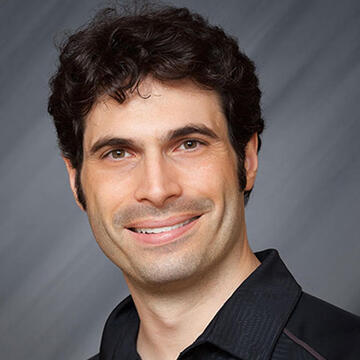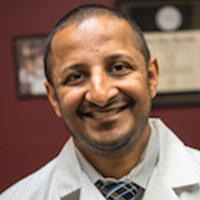Able to handle almost anything. That’s the way we think about top urban hospital emergency departments.
If you’re in dire need, if your primary care doctor can't see you, it’s frequently where you end up. They’re the front doors to hospitals as well as the safety nets. That people suspected of having COVID-19, the novel coronavirus that has killed more than 250 Nevadans and more than 250,000 people around the world, end up in emergency departments is no surprise.
Within minutes of a patient’s arrival, emergency physicians and their colleagues go to work on the front lines, treating and testing for a disease no one has seen before. Six UNLV School of Medicine emergency medicine physicians, who work in UMC’s emergency department, share what they’ve learned about the virus, people, themselves, and their colleagues.
Dr. Ross Berkeley

A professor and interim chair of the UNLV School of Medicine department of emergency medicine, as well as program director of the emergency medicine residency program, Berkeley was one of the two Las Vegas Metropolitan Police Department SWAT team physicians at Mandalay Bay on the evening of the Oct. 1, 2017, massacre on the Strip — 58 people were killed and 415 wounded.
He refers to the COVID-19 outbreak as a “mass casualty incident in slow motion” and views the current health care system response as a dress rehearsal for the next pandemic or mass casualty incident yet to come. “I think this gives us a lot of insight into how to best handle situations in the future.” During the early days of the outbreak, he participated in daily Zoom conferences with physicians and health care professionals from across the country — some as long six hours — to discuss constantly evolving best practices, as well as to plan the logistics of the departmental response. Would hydroxychloroquine, an anti-malaria drug, be the treatment of choice, or perhaps antiviral medications? Would it be best to position someone with breathing problems on their abdomen instead of their back? There were many questions, he said, but never any definitive answers.
To help ensure there was no cross-contamination of potentially infected patients with others in the emergency department, a wall was built inside a hallway adjacent to the emergency department at the University Medical Center (UMC) to create an atrium for a ‘split triage’ process. Berkeley said this worked as he and other health care professionals hoped it would. In order to avoid potential viral crossover, those with suspected COVID-19 disease were directed into the atrium for further evaluation in a dedicated area formerly used as an observation suite, while patients with other medical problems went to the main emergency department.
Berkeley also talks about the power of fear during this pandemic, and the “heartbreaking” impact he has seen on our community – many people have been so afraid of the virus they didn’t come to the emergency department when they had significant medical problems. “One woman who had been stabbed twice in the chest didn’t come to the Trauma Center for several days because she was afraid of the virus.”
Dr. JD McCourt

An associate professor in the school’s department of emergency medicine, as well as medical director of the UMC adult emergency department and vice chair for clinical operations, McCourt said, “The spectrum of the COVID-19 disease is crazy...it presents mild, asymptomatic, or horribly sick. I can’t tell you why one person gets so sick and the other doesn’t, why this guy does bad and this guy does good. What’s really been strange is that we’ve seen a lot of serious cases in young, healthy people with no comorbidities. I’ve never seen something unfold like this. You can’t look it up. You don't know what your management plan is.
"The information is shared from all the specialties. It can come from Zoom conferences from New York, from podcasts. I have been practicing for over 30 years but I have never seen a disease unfold so quickly, requiring the entire medical community to work together to come up with ways to treat a disease that there is no data to reference. Most of the information and techniques used are treatments that work for other diseases, but are used here in real time as trial and error.”
Dr. Christian Young

An assistant professor in the school’s department of emergency medicine and assistant program director for the emergency medicine residency, Young said what he has found most memorable about the COVID-19 outbreak from a clinical standpoint is how well some very sick patients appeared.
“On one of the first cases of coronavirus that I responded to, I distinctly remember pausing for a moment thinking that this patient wasn’t that sick. I was able to have a conversation with him. He was wide awake, lucid, and even joking with me. Looking at his vital signs, though, it was clear that he was not doing well and needed to be intubated. As an emergency physician, one thing you develop a sense for is knowing when a patient is sick or not sick and this disease definitely challenges that, because the patients just don’t look that sick when they are first presenting with this infection. That particular patient ended up dying a few days later. Even though I’ve taken care of patients who were more critically ill than him in the subsequent weeks of the pandemic, I think I’ll always remember that conversation we had. It was very pleasant and hard to believe it was his last conversation. I remember him thanking me as the respiratory therapist and nurses assembled to proceed with the procedure. The procedure went very smoothly, and I recall leaving the room thinking that the patient would be on the ventilator for a few days and would then recover. I have learned in the subsequent weeks that doesn’t always happen.”
Dr. Jason David

A chief resident of the school’s department of emergency medicine, David said that if the pandemic were to end today he’d “remember how tough this was on families, including those of our residents. I’ll remember how some of our residents, with chronically ill family members, had to resort to sleeping in hotels or trailers in order to protect them, and how others continued to take care of patients even with their own family members in the hospital at the same time.”
While David studied pandemics in medical school, he said that now that he’s in the middle of one in an emergency department, he finds it “surreal. We’re discovering how better to treat this disease every shift. It feels like we’re living history. Medical personnel — first responders, nurses, advanced practice providers, physicians — we’ve all had a rough go of it in the past several years as the medical system has become more dependent on us as the ‘social safety net’ for the underserved in our society. Now that a pandemic is here, we’re seeing how much that already heavily burdened system can stretch — because the emergencies still keep coming, and the forgotten members of our society still come here looking for help. I think this crisis is in many ways a reckoning for that system, and if anything good comes from this time, then I really hope it serves as a catalyst for change.”
Dr. Ketan Patel

An assistant professor in the school’s department of emergency medicine, as well as associate director of the emergency medicine residency, Patel lives with his pregnant wife, their young son, his brother, and his 71-year-old father and 69-year-old mother. “The concern for me was never coming down with the virus, but keeping it away from them. At the onset of the outbreak locally, I got sick with a fever and body aches and was placed on quarantine and pulled off shifts. I had such an immense fear of my family contracting the disease and it was a true worry for me. I had isolated myself in our guest room, but it was tough to completely isolate myself from my entire family. The other members of my household have also been sick but fortunately have recovered. I recently tested positive for antibodies to the virus. I pray daily that they are all immune as am I, as this risk to myself and my loved ones will not end in days, weeks, months, or even years. I’ve realized that due to the nature of my profession, I am always at risk, and by proxy they are as well.”
Dr. David Obert

A clinical assistant professor in the school’s department of emergency medicine and associate medical director of the UMC adult emergency department, Obert said that how a lifelong friend stepped up during the COVID-19 outbreak is something that not only helped health care providers and first responders in Las Vegas, but the entire country.
It turns out that a little more than a month ago his friend, Kevin Stevenson, who owns a family-run paper and plastic manufacturing company in Southern California, was checking in with Obert to see how he was doing during the crisis.
“I expressed my concerns regarding access to PPE (personal protective equipment) and face shield shortages throughout the country," Obert said. "He then asked if he could help. He took what was a basic design I gave him, developed a die, and within a day, had figured out how he could convert one of his machines to manufacture thousands of face shields to help protect UMC and EMS providers in the Las Vegas community. Kevin partnered with his friend across the street who owns and operates Pomona Quality Foam.
"Together, these companies designed the best product they could with the limited amount of resources they had access to. After they had shipped me some test products and we modified a little more, they shipped us 3,000. This 3,000-unit order then blossomed into 10,000 units, which then grew to 250,000 units, which then grew into millions. Both of the businesses involved here, FDS and Pomona Quality Foam, were hours from laying off roughly 50 employees due to the economy. They were able to keep everyone employed and make it through the worst recession their businesses have ever faced. I will carry this story with me for a lifetime.”


